Impact of Anthropogenic Aerosols on Summer Precipitation in the Beijing–Tianjin–Hebei Urban Agglomeration in China: Regional Climate Modeling Using WRF-Chem
Jun WANG,Jinming FENG*,Qizhong WU,and Zhongwei YAN
1Key Laboratory of Regional Climate-Environment for Temperate East Asia, Institute of Atmospheric Physics,Chinese Academy of Sciences,Beijing 100029
2College of Global Change and Earth System Science,Beijing Normal University,Beijing 100875
Impact of Anthropogenic Aerosols on Summer Precipitation in the Beijing–Tianjin–Hebei Urban Agglomeration in China: Regional Climate Modeling Using WRF-Chem
Jun WANG1,Jinming FENG*1,Qizhong WU2,and Zhongwei YAN1
1Key Laboratory of Regional Climate-Environment for Temperate East Asia, Institute of Atmospheric Physics,Chinese Academy of Sciences,Beijing 100029
2College of Global Change and Earth System Science,Beijing Normal University,Beijing 100875
The WRF model with chemistry(WRF-Chem)was employed to simulate the impacts of anthropogenic aerosols on summer precipitation over the Beijing–Tianjin–Hebei urban agglomeration in China.Withtheaid of a high-resolution gridded inventory of anthropogenic emissions of trace gases and aerosols,we conducted relatively long-term regional simulations, considering direct,semi-direct and indirect effects of the aerosols.Comparing the results of sensitivity experiments with and without emissions,it was found that anthropogenic aerosols tended to enhance summer precipitation over the metropolitan areas.Domain-averaged rainfall was increased throughout the day,except for the time around noon.Aerosols shifted the precipitation probability distribution from light or moderate to extreme rain.Further analysis showed that the anthropogenic aerosol radiative forcing had a cooling effect at the land surface,but a warming effect in the atmosphere.However,enhanced convective strength and updrafts accompanied by water vapor increases and cyclone-like wind shear anomalies were found in the urban areas.These responses may originate from cloud microphysical effects of aerosols on convection,which were identified as the primary cause for the summer rainfall enhancement.
anthropogenic aerosols,summer precipitation,urban agglomeration,regional climate
1.Introduction
The Beijing–Tianjin–Hebei urban agglomeration is located on the North China Plain,and includes several megacities with tens of millions of inhabitants.With its rapid urban expansion and industrial development,large amounts of anthropogenic aerosols and their precursors have been emitted into the atmosphere over the past several decades,causing the area to be one of the most heavily polluted regions in the world(Duan et al.,2004;Chan and Yao,2008).Many works have reported that urban and industrial air pollution has the potential to change rainfall by modulating solar radiation processes and acting as cloud condensation nuclei in cloud systems in various climate regimes(Rosenfeld,2000; Ramanathan et al.,2001;Rosenfeld et al.,2007).Within the East Asian monsoonmarginalbelt,urbanfloodingand severe water shortages are becoming major environmental disasters for the Beijing–Tianjin–Hebei urban agglomeration.Under-standing responses of rainfall to anthropogenic aerosols and related physical processes are particularly critical to sustainabledevelopmentinthis region(e.g.,freshwatermanagement and urban design planning).
Rainfall modification over major metropolitan areas has been extensively studied.Most studies have highlighted the effects of urbanland-use on rainfall anomalies(Shepherdand Burian,2003;Shepherd,2005;Shem and Shepherd,2009; Niyogi et al.,2011).Besides the effects of urban land-use, urban precipitation patterns can also be modified by anthropogenic aerosols.Anthropogenic aerosols reflect and scatter solar radiation,altering the energy budget and ultimately cooling the climate system(Kaufman et al.,2002;Andreae et al.,2005).Depending on chemical composition(e.g.,elemental carbon),they can absorb sunlight,further reducing solar radiation that reaches the land surface and heating the atmosphere.The asymmetry of temperature changes at the surface and in the atmosphere increases atmospheric stability and impedes convective activity,even rainfall.Serving as cloud condensation nuclei(CCN),aerosols increase nuclei number concentrations,modify the cloud drop size spec-trum,and inhibit collision/coalescenceprocesses(Rosenfeld, 1999).On the other hand,studies have found that giant CCN overurbanareas could increase the clouddroplet effectiveradius and enhancerain formation(van den Heever and Cotton, 2007).Numerous works have shown evidence that when the convective cloud base is warm and low,aerosols from pollution could delay warm rain formation,prevent the decrease in vertical velocity caused by the falling raindrops,and increase water for conversion into ice hydrometeors(Li et al., 2011).This would release more latent heat and further invigorate convectivesystems(Khainet al.,2005;Rosenfeld et al., 2008).
©Institute of Atmospheric Physics/Chinese Academy of Sciences,and Science Press and Springer-Verlag Berlin Heidelberg 2016
As the main source of anthropogenic aerosols,urban areas provide an ideal setting for studies on aerosol-induced rainfall modification.In fact,many recent studies have attempted to examine the connections between variation in aerosol concentrations and changes in cloud properties and precipitation over urban areas.In a study carried out in metropolitan Atlanta,Lacke et al.(2009)found that instability is greater and mixing layers shallower on days with high aerosol concentrations,resulting in greater precipitation amounts in most parts of the region.Although observational analyses have revealed some evidence of aerosolinduced precipitation changes,the physical mechanisms pertaining to the modification of regional rainfall by aerosols over urban areas remain elusive.Numerical modeling is a useful tool for revealing the physical processes involved in the interactionsamongaerosols,cloudsandrainfall.Through the use of a cloud-resolvingRAMS,van den Heever and Cotton(2007)foundthaturban-forcedconvergencedownwindof a city was influenced by the presence of greater aerosol concentrations.Wang et al.(2011)employedthe cloud-resolving WRF model with a two-moment bulk microphysical scheme to simulate a mesoscale convective system in the Guangzhou megacity area,and found that precipitation and a lightning potential index increased by 16%and 50%,respectively,under the polluted aerosol conditions.Through numerical experiments,Qian et al.(2014)investigated the local radiative forcing of black carbon in snow over Northern China.Using the WRF model coupled with a chemistry component,and a snow/ice/aerosol radiative model,Zhao et al.(2014)simulated the radiative forcing of black carbon and dust in seasonalsnow overNorthChina.Using the WRF modelcoupled with spectral-bin microphysics,Fan et al.(2012)examined the aerosol indirect effects on clouds and precipitation of the warm and cold seasons in Southeast China.A comprehensive review of modeling studies on the effects of aerosols on precipitation was presented by Khain(2009).However,most previous studies used only a single rainfall event to investigate the responses of precipitation to aerosols,limiting the universality of their conclusions.Therefore,further understanding of the physical processes controlling the impacts of anthropogenicaerosolson urbanprecipitationwith numerous rainfall events is critical.
The objective of the present work is to investigate the responses of urban summer precipitation to anthropogenic aerosols over the Beijing–Tianjin–Hebei urban agglomeration and understand the related dominant mechanisms.The paper is organized as follows:The model,experimental design,and emission data are described in section 2.The main results are presented and discussed in section 3,followed by conclusion and implications of the findings in section 4.
2.Model and data
2.1.Model description
The model used in this study is the WRF model coupled with chemistry(WRF-Chem),version 3.5.1(Grell et al.,2005;Fast et al.,2006).WRF-Chem treats emissions, transport,horizontal and vertical mixing,transformation of trace gases and particulates,and dry and wet deposition simultaneously with meteorology.It parameterizes the interactions among aerosols,radiation processes,and cloud microphysics,consideringdirect,semi-directandindirecteffects of aerosols,as described in Fast et al.(2006).WRF-Chem has been widely applied in weather and air quality forecasting, and regional climate studies,and has shown satisfying simulation skill(McKeenet al.,2007;Fast et al.,2009;Qian et al., 2009a;Zhang et al.,2009b;Zhang and Dubey,2009;Wang et al.,2010;Tuccella et al.,2012).
The WRF-Chem physical packages used in the present study included the new version of the RRTM(Iacono et al., 2008),Lin cloud microphysics scheme(Lin et al.,1983; Chen and Sun,2002),new Grell cumulus scheme(Grell and D´ev´enyi,2002),Mellor–Yamada–Janji´c PBL scheme(Mellor and Yamada,1982;Janji´c,1994),and Noah land surface scheme(Chen and Dudhia,2001)coupled with a single-layer urban canopy model(Kusaka et al.,2001).In WRF-Chem, the Lin cloud microphysics scheme was added with a prognostic treatment of cloud droplet number based on aerosol number concentration,which enabled WRF-Chem to simulate aerosol indirect effects.The parameterizations of Liu et al.(2005)were introduced to enable the auto-conversion from cloud droplets to rain droplets based on droplet number concentrations.By turning on the option of prognostic number density,we enabled the Lin scheme to be a two-moment cloudmicrophysicsscheme,containingice,snowandgraupel processes,which may be suitable for the high-resolutionsimulations of precipitation produced by stratiform clouds and convective clouds.
Thechemistryschemesusedin thepresentstudyincluded the second generation Regional Acid Deposition Model gas phase chemical mechanism(Stockwell et al.,1990)and the ModalAerosolDynamicsmodelforEurope(MADE)aerosol dynamic module(Ackermann et al.,1998;Schell et al., 2001).The MADE aerosol module uses a modal approach with three modes(Aitken,accumulation,and coarse modes, with assumptionof a log-normalsize distributionwithin each mode)to describe particulate size distributions.This aerosol module requires less computational resource than the sectional approach that discretizes the aerosol size distribution into many bins.Cloud chemistry and aerosol wet scavenging were enabled during the simulations.All these meteorologyand chemistry options were identical for all domains.
2.2.Experimental design
To elucidate the effects of anthropogenic aerosols on urban summer rainfall,we conducted two sensitivity experiments with different emission scenarios:an absolutely clean case(C-case)and recently polluted case(P-case).In C-case, anthropogenic gases and aerosol emissions were turned off. In P-case,the anthropogenic emissions of all the domains were updated using the corresponding resolution inventory dataset.For the innermost domain,a high-resolution emissions inventory dataset was used,which will be discussed in detail in the next section.To refine the temporal resolution of the emissions inventory,WRF-Chem is designed to create two emissions files that contain hourly emissions from 0000 LST(local standard time)to 1100 LST,and 1200 LST to 2300 LST.This emissions inventory was refined to be representative of a typical summer polluted day in the Beijing–Tianjin–Hebei urban agglomeration,and provided the regional aerosol emissions on each day during the simulations.
Three one-way nested domains were configured.As showninFig.1a,theouterdomain(D1)coveredmostofeastern China(21°–50°N,101°–129°E),the finer domain(D2) provided full coverage over North China,and the innermost domain(D3)centered over the Beijing–Tianjin–Hebei urban agglomeration.The horizontal grids of the three domains were 97×112,136×163,and 148×151,with horizontal grid spacing of 30 km,10 km,and 3.3 km,respectively. The default MODIS-based land-use classification contained in WRF-Chem for the innermost domain(D3)is denoted in Fig.1b.The model had 30 vertical levels,with an uppermost pressure of 50 hPa.As this study focuses on the impact of anthropogenic aerosols on large-scale precipitation,not theboundary layer processes,the setting of the vertical levels should have little influence on the main results.Since we investigated the impacts of anthropogenic aerosols on summer precipitation,concentrating on July,numerical simulations for the July of 2008were conducted.Simulationsbeganfrom 29 June and endedon 1 August,and the first two days in June were used for model spin-up,which could largely eliminate the bias caused by uncertainties in the initial conditions.Initial and boundary meteorological conditions were provided by the six-hourly NCEP-FNL dataset with 1.0°×1.0°grids. Sea surface and deepsoil temperatureswere updatedwith the reanalysis data during the simulations.

Fig.1.(a)WRF-Chem configuration for the three nested domains.Shadings represent terrain heights(units:m)and the innermost domain encompasses the Beijing–Tianjin–Hebei urban agglomeration.(b)Default MODIS-based landuse classification contained in WRF-Chem for the innermost domain(D3).Red patches denote urbanized areas.
2.3.Emissions data
A high-quality emissions inventory is fundamental for aerosol modeling studies.To accurately describe spatiotemporal distributions of aerosol particulates in urban areas,an anthropogenic emissions inventory dataset with very high spatiotemporal resolution is required.A number of representative global and regional inventory datasets have been developed.However,the spatiotemporal resolutions of these datasets are too coarse to meet the requirements of research on the effects of aerosols at the urban scale.
Owing to the Beijing 2008 Summer Olympic Games, a more comprehensive environmental measurement network was established to monitor the air quality continuously. Researchers surveyed the emissions intensity for all types of atmospheric pollution in Beijing and the surrounding provinces,including Tianjin and Hebei,and developed an emissions inventory of sources such as power plants,transportation,andindustrialenergyconsumption.Two categories ofdatasets wereconsideredforthe establishmentofthe emissions inventory.One was the regional emissions inventory from TRACE P(Streets et al.,2003)for the year 2002 and INTEX-B(Zhang et al.,2009a)for the year 2006.Another was the local emissions dataset covering Beijing and its surrounding provinces,which integrated the power plant emissions inventory in North China,the major industrial emissions in Tianjin and Hebei,and detailed local emissions(domestic,transportation and industry)in Beijing.This emissions dataset has been used in Wu et al.(2011)and Wu et al.(2014)for air quality studies and operational forecasting in Beijing.The investigators further refined the size distributions and compositions of all aerosol species.Wu et al. (2012,2014)indicated that model performance in simulating PM10was improved significantly after emissions processes were updated by this emissions inventory.We applied this database as an anthropogenic emissions inventory to represent pollution sources over the Beijing–Tianjin–Hebei metropolis.Spatial distributions of daily mean emissions intensities of the major anthropogenic pollutants(gases:SO2, NO2,NO,CO and NH3;aerosols:elemental carbon,sulfate, nitrates,PM2.5and PM10)are displayed in Fig.2.It can be seen that the gases and aerosols concentrated over the major urban areas and main roads.Specifically,the concentrations of PM2.5and PM10were extremely high over the metropolitan areas,like Beijing.
3.Results
3.1.Model evaluation
Station-observed rainfall data from the China Meteorological Administration were used to validate model performance(Fig.3a).Precipitation data from the chosen meteorological stations had no missing values and passed strict quality control.As shown in Fig.3b,WRF-Chem generally capturedtheregional-scalecharacteristicsofprecipitationinJuly 2008.However,the model tendedto overestimatethe amount of precipitation,and the simulation skill in C-case was better than that in P-case.The spatial correlation between C-case (P-case)simulated and observed monthly mean precipitation was 0.53(0.68).Model biases of rainfall may have resulted from inaccurate initial and boundary conditions and the performance of certain parameterization schemes(e.g.,cumulus and cloud microphysics).Given that we computed differences of simulation results in sensitivity experiments,the modelsystematicbiasshouldhavebeencancelledout,having little effect on the applicability of our conclusion.
3.2.Responses of summer precipitation to anthropogenic aerosols
Figure 4a displays the difference in mean precipitation patterns simulated by C-case and P-case in the Beijing–Tianjin–Hebei urban agglomeration.Anthropogenicaerosols enhanced rainfall over most parts of the urban agglomeration (D3).Figure 4b depicts the diurnal variation of the domainaveraged hourly rainfall rate over D3 from the simulation results of the two cases.Due to the effects of anthropogenic aerosols,hourly precipitation declined slightly around noon but noticeably increased in the afternoon and at nighttime. The most pronounced change was at 0000 LST,reaching nearly 50%of the simulated precipitation in C-case.
To further examine the responses of different types of summer precipitation to the anthropogenic aerosols,we classified the model grids into five categories based on monthly averaged daily rainfall amount(extreme rain:>10 mm d-1; heavy rain:5–10 mm d-1;moderate rain:2–5 mm d-1;light rain:1–2 mm d-1;and drizzle rain:<1 mm d-1).Given that the mean rainfall amount for each grid is calculated for the entire simulation period,including many no-rain days, our classification scheme is reasonable and comparable with other studies(Qian et al.,2007;Wang et al.,2011).Figure 4c shows the percentages of grid areas at the five precipitation levels simulated in the two cases.The results reveal that the anthropogenicaerosols tendedto cause light or moderaterain to fall on smaller geographicareas.Figure 4d displays the ratios of precipitation amount under different categories over the total precipitation amount simulated by the two cases. Theresults show that thelight andmoderaterain decreasedin P-case,butrainfallmagnitudesincreasedfortheextremerain. This change implies that the anthropogenic aerosols tended to shift precipitation from lower to higher amounts.Based on observational analysis and numerical simulation results, Qian et al.(2009b)also suggested that significantlyincreased aerosol concentrations caused by air pollution were likely tohave decreased light rain events in China over the past 50 years.This finding is highly consistent with the simulated responses of summer precipitationto anthropogenicaerosols in the present study.
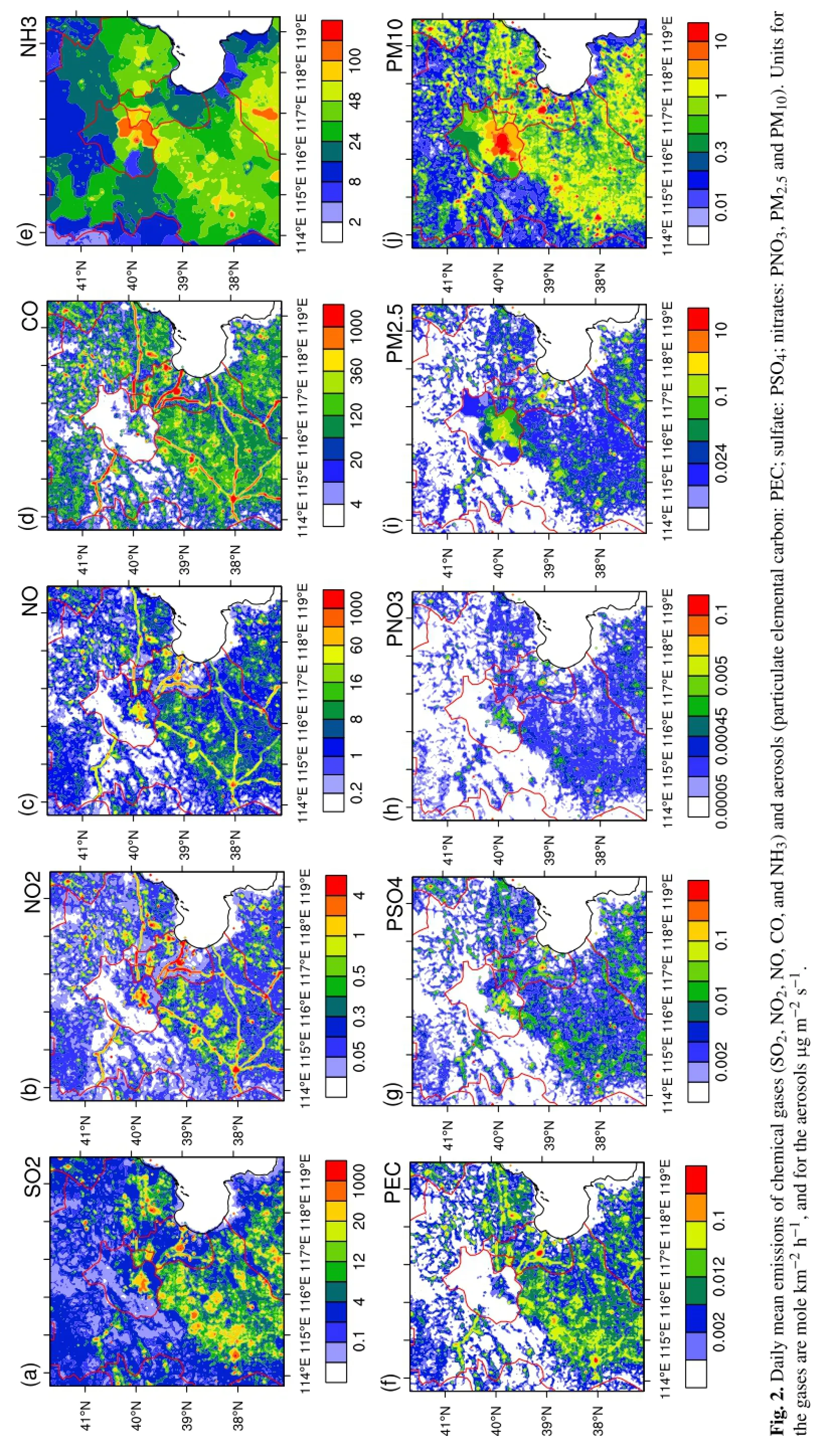
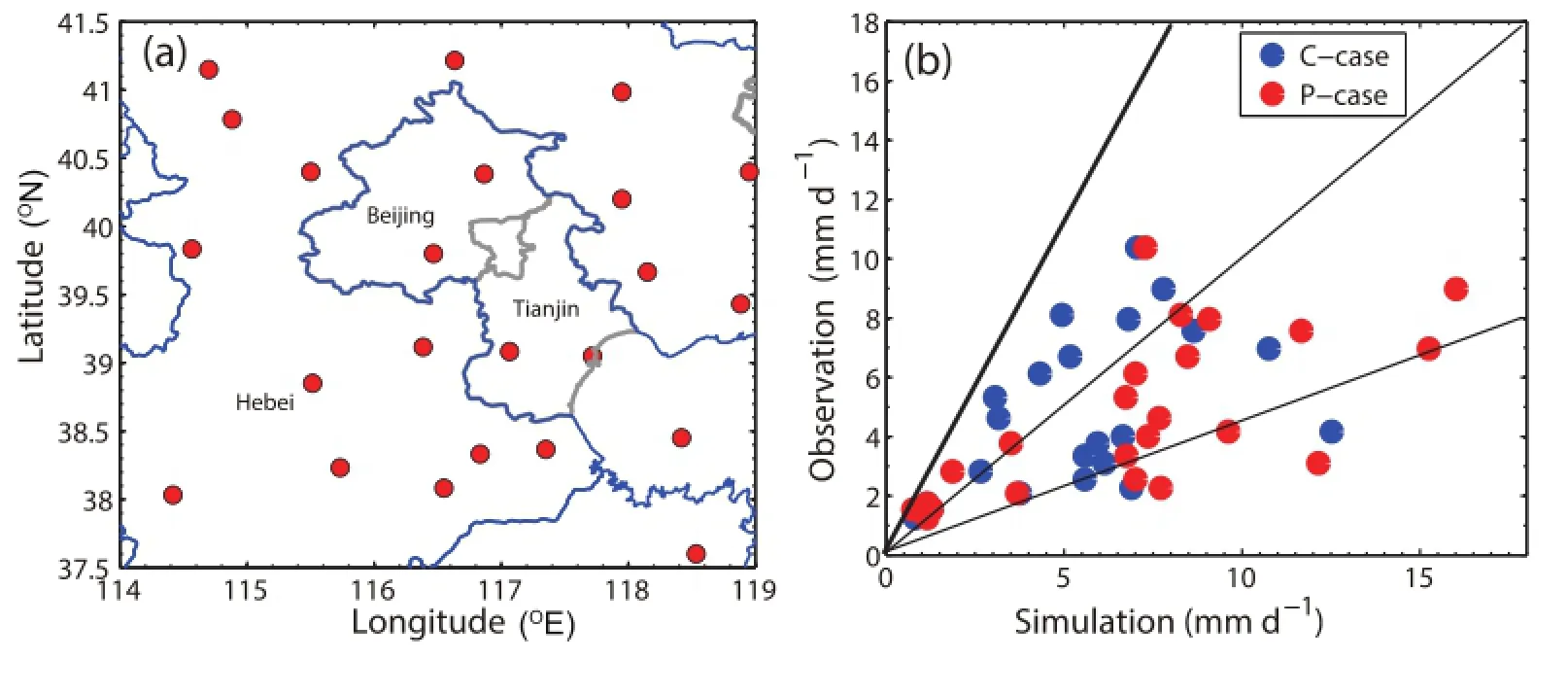
Fig.3.(a)Geographical distribution of meteorological stations over the Beijing–Tianjin–Hebei urban agglomeration.(b)Quantile-quantile plot:blue(red)dots indicate comparison between C-case(P-case) simulated and observed monthly mean precipitation in July 2008.The three lines indicate y=0.5x,y=x, and y=2x,respectively.
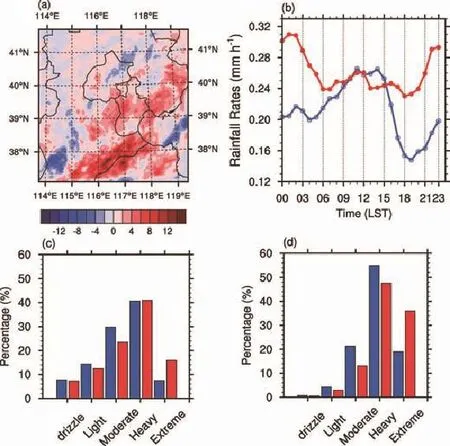
Fig.4.(a)Change(P-case minus C-case)of mean daily precipitation pattern caused by anthropogenic aerosols(mm d-1).(b)Diurnal variation of rainfall simulated by C-case(blue line)and P-case(red line).(c)Percentages of grid areas in five precipitation categories over the entire domain simulated by C-case(blue bars)and P-case(red bars).(d)Percentages of rainfall amount in five precipitation categories simulated by C-case(blue bars)and P-case(red bars).

Fig.5.Averaged all-sky shortwave(SW,left),longwave(LW,middle)and total(right)radiative forcing induced by anthropogenic aerosols over the Beijing–Tianjin–Hebei urban agglomeration.“TOA”represents aerosol radiative forcing at the top of the atmosphere,with upward direction indicated by positive values;“ATM”represents aerosol radiative forcing in the atmosphere,with warming indicated by positive values;“LAND”represents aerosol radiative forcing at the surface with positive values signifying more radiation received at the land surface;and“Total”represents the sum of aerosol SW and LW radiative forcing.Units are W m-2.
3.3.Radiative forcing and surface heat flux changes
Since the climate system,including the hydrological cycle,is primarily fueled by radiative energy,investigation of aerosol-inducedradiative forcingis essential.Figure 5 shows the spatial distributions of differences between the two cases in simulated shortwave(SW),longwave(LW)and net radiation(SW+LW)at the TOA,in the atmospheric column (ATM),and at the land surface(LAND).Because of the higheralbedooftheearthandincreasedcloudfractioncaused by aerosols,more SW radiation was reflected back to space and the domain-averaged SW radiative forcing was negativeat the TOA(-9.1 W m-2).The LW radiative forcing at the TOA was positive or close to zero(+2.5 W m-2).The net radiative forcing by anthropogenic aerosols at the TOA was negative(-6.6 W m-2).In the ATM,a portion of SW radiation was absorbed by certain types of anthropogenic aerosols (e.g.,elemental carbon),producing a positive SW radiative forcing(+9.0W m-2)andwarmingofthe atmosphere.A less pronounced SW radiative forcing in the ATM was found in the northern mountain area,owing to a weaker aerosol emissions intensity there(Fig.2).The aerosols increased atmospheric outgoing LW radiation in excess of that which they absorbed,resulting in a negative LW radiation forcing in the ATM(-2.9 W m-2).Note that the direct effect of aerosols on LW radiation should be negligible and the“radiative forcing”referred to here is actually the radiative response to aerosol effects.SincetheabsolutevalueofaerosolSW radiationforcing was higher than LW in the ATM,the atmospheric column was warmed by the net radiative forcing of aerosols,with an area-averagevalue of+6.1 W m-2.As for LAND,downward SW radiation was reducedby the absorptionand scatteringof anthropogenic aerosols,and the increased cloud amount(the cloud fraction and cloud liquid water path)(-18.1 W m-2). LW radiation emitted by the land surface was trapped and returned by clouds and aerosols(+5.4 W m-2).The net radiative forcingof anthropogenicaerosols at LAND was negative (-12.7 W m-2),resulting in cooling of that surface.
The thermodynamic effects of surface sensible heat flux and direct moisture supply from surface latent heat flux are critical for the initiation and development of convection (Orville et al.,1981).We calculated the changes of surface sensible and latent heat fluxes induced by anthropogenic aerosols(figurenotshown).Itwasfoundthattherewas asubstantial decrease in sensible heat flux over the urban areas.In the suburban and rural areas,sensible heat flux was also inhibitedbut withsmallermagnitudes.Thedecreaseinsensible heat flux can be attributed to the decreased surface temperature(figure not shown).Surface latent heat flux also greatly decreased,particularly over the southern plain.A small increase in latent heat flux in central urbanareas may be caused by the increase in precipitation.
By analyzing the simulation results for the physical mechanisms affecting precipitation in Beijing,Miao et al. (2011)highlighted the role of thermal transport(including surface sensible and latent heat)in changes of urban rainfall amount,which is morecritical than momentumtransport. However,in this study,aerosol-induced changes in thermal heating of the surface appear to contradict the simulated pattern of the rainfall response.Therefore,we cautiously infer that the physical mechanismsdominatingthe summerprecipitation modification may not be closely or directly associated with radiative forcing and thermal heating changes caused by anthropogenic aerosols.
3.4.Changes in convective strength
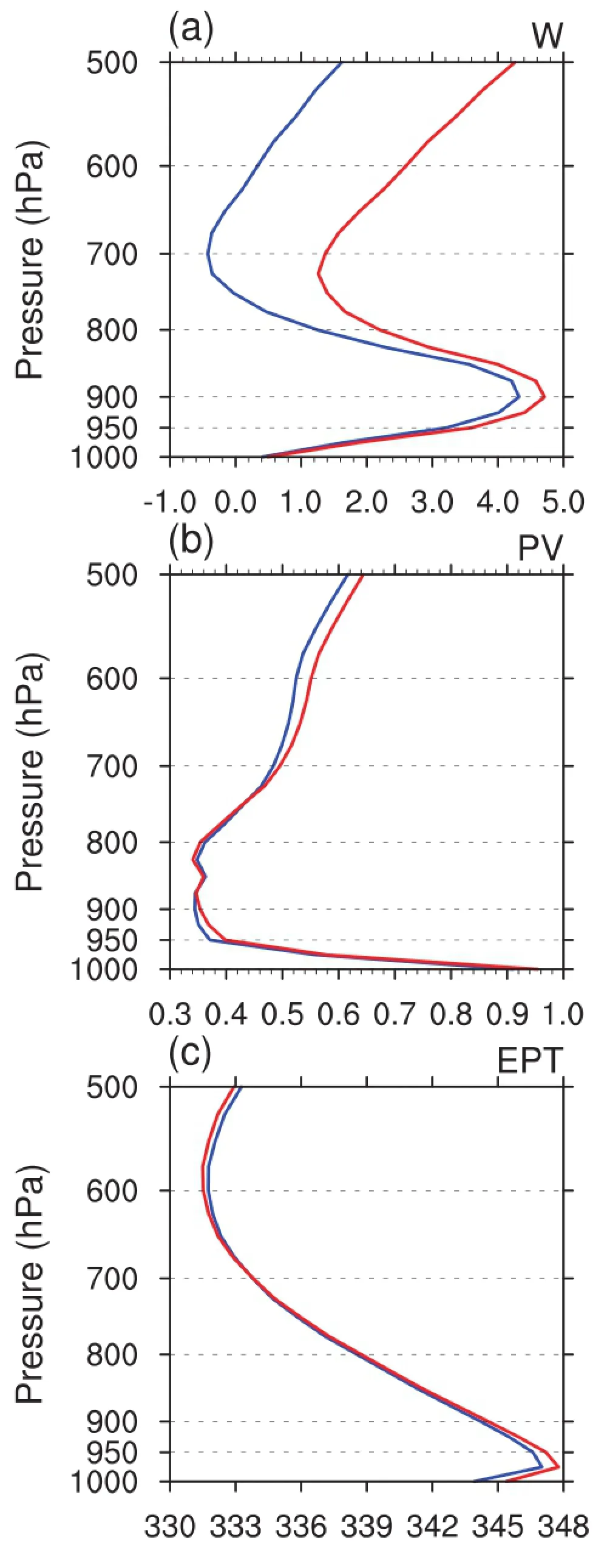
Fig.6.Profiles of(a)vertical velocity,(b)potential vorticity, and(c)equivalent potential temperature averaged over the entire area simulated by C-case(blue line)and P-case(red line). Units for vertical velocity are mm s-1,for potential vorticity PVU(PV units,10-6m-2s-1K kg-1),and for equivalent potential temperature K.
Since convective rainfall dominates summer precipitation in this metropolitanregion,other related thermodynamic variables require further investigation to unravel potentialcauses for the precipitation change.Vertical profiles of vertical velocity,PV and equivalent potential temperature(EPT) simulated by the two cases are shown in Fig.6.As shown in Fig.6a,verticalmotionsareenhancedduetotheeffects ofanthropogenic aerosols.In P-case,anthropogenicaerosols generated more positive PV in the lower and middle atmosphere, also implying stronger upward motions,which tended to enhance precipitation.The domain-averaged EPT increased in the lower atmosphere but decreased above,which is indicative of a more unstable atmosphere.
To validate this argumentand furtherreveal the responses of atmospheric thermodynamic conditions to the anthropogenic aerosols,the changes in CAPE(the amount of energy obtained by a parcel of air if lifted a certain distance vertically through the atmosphere)and convective inhibition energy(CIN,the amount of the energy that prevents an air parcel from rising from a certain altitude to the level of free convection)caused by anthropogenic aerosols are shown in Figs.7a and b.CAPE increased over most areas of rainfall increase(Tianjin and southern Hebei Province)due to the effects of aerosols.CIN over these areas decreased,with less magnitude than CAPE.As CAPE is an effective indicator of atmospheric instability and is often used to predict convection,this suggested that convective strength over the urban areas was likely enhanced by the aerosols.
3.5.Circulation and water vapor changes
Changes in convective strength due to anthropogenic aerosols reflect pronounced variation in regional circulations and water vapor.Figures 8a and b show changes in lower atmosphere(10 m and 850 hPa levels)circulation and water vapor mixing ratio,induced by the anthropogenic aerosols. The simulation results indicated that wind convergence was greatly enhanced over the southern part of Beijing.Water vapor was increased in the urban areas but declined slightly in other areas,a pattern coincident with the precipitation change.This water vapor change may be caused by the convergent flow and aerosol indirect effects,which are discussed in detail below.Figures 8c and d portray circulation changes in the mid-troposphere(700 hPa and 500 hPa levels) produced by the anthropogenic aerosols.Cyclone-like wind shear was located over the urban areas.Therefore,the anthropogenic aerosols tended to strengthen the convergence zonein theregionofrainfallenhancement.Theredistribution of water vapor and various responses of atmospheric circulation to anthropogenic aerosols explain the pattern of rainfall change very well,but the primary reasons for the change of summer precipitation over the Beijing–Tianjin–Hebei urban agglomeration need further exploration.
3.6.Changes in cloud microphysical properties
To gain further insight into aerosol effects on convection, clouds and rainfall,we investigated simulated microphysical properties under the clean and polluted aerosol conditions. Additional aerosol particulates can be activated to act as condensation nuclei,which tend to increase cloud droplets under certain water vapor conditions.Figure 9a shows the vertical profiles of domain-averaged droplet number concentrationsimulatedinthetwocases.InP-case,thesimulatedcloud droplet number concentration was much higher than in C-case.More cloud droplets increased the cloud water mixing ratio(Fig.9b)and slowed auto-conversion from cloud droplets to raindrops.The smaller water droplets could be lifted to higher altitudes by strong convective airflow and became frozen above the 0°C isotherm level.As shown in Fig. 9d,themixingratiosof cloudhydrometeorssuchas ice,snowand graupel were all increased,indicating that more water droplets were elevated to the freezing level.The simulation results conformto the analyses of in situ,satellite and aircraft observations(Rosenfeld and Woodley,2003;Andreae et al., 2004).As cloud droplets were converted to ice-phase hydrometeors,greater amounts of latent heat were released and remainedin theatmosphere,whichcausedmanychangesthat invigoratedconvectivesystems,andrainfallrates werefinally enhanced(Fig.9c).
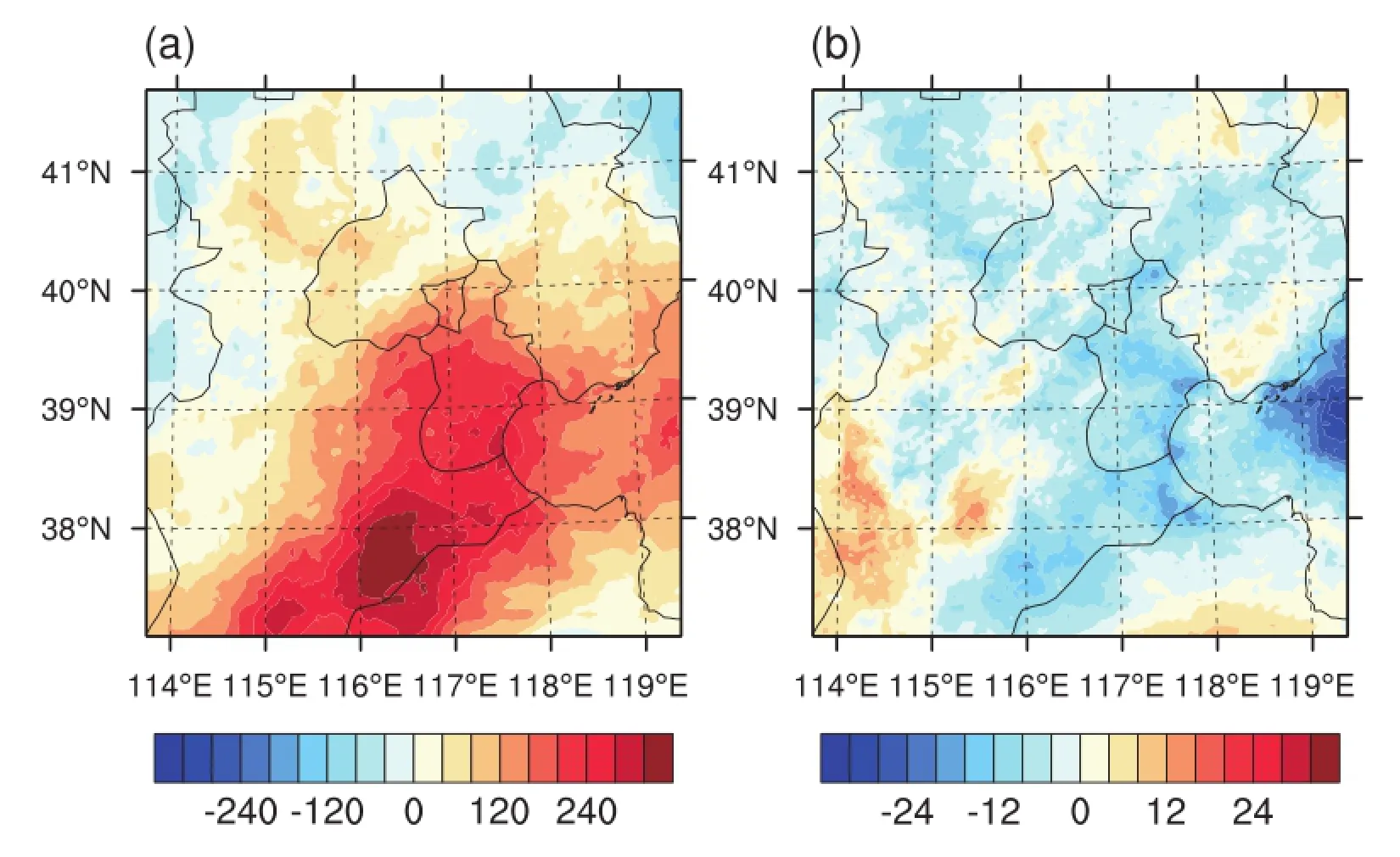
Fig.7.Changes(P-case minus C-case)of(a)convective available potential energy and(b)convective inhibition energy.Units are J s-1.
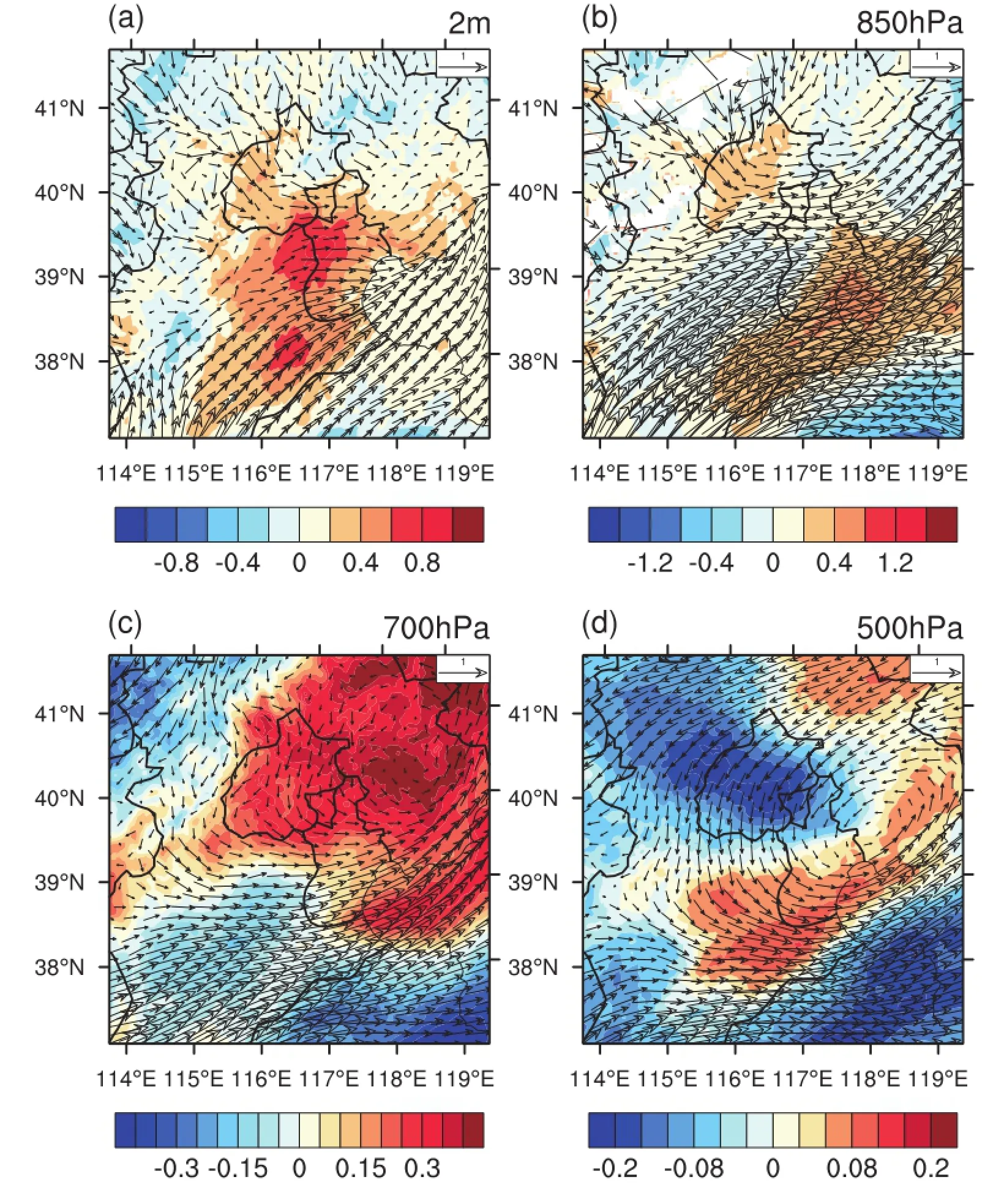
Fig.8.Changes in circulation and water vapor mixing ratio on the level of(a)2 m,(b)850 hPa,(c)700 hPa,and(d)500 hPa.Units for wind speed are m s-1,and for water mixing ratio are g kg-1.
Figures 10a and b illustrate the temporal evolution of simulated microphysical latent heating profiles under different pollution conditions.Microphysical latent heat release related to cloud water phase transition mainly appeared at nighttime and in the afternoon,consistent with the time of the precipitation maximum during the daytime.Figure 10c shows that the difference in microphysical latent heating above the level of 700 hPa between P-case and C-case was positive,indicating that the increased condensation from water drops due to anthropogenic aerosols enhanced the latent heat release.The increase in microphysical latent heating was mainly observed at late night and in the early morning,coinciding well with the periods of rainfall enhancement (Fig.4b).The stronger negative microphysical latent heating from the level of 900 hPa to 700 hPa may be related to the enhanced ice melt and rain evaporation.Changes in microphysical latent heating induced by aerosol indirect effects may be the leading cause of the changes in convective strength,atmosphericinstability,horizontalcirculation,watervapor,and ultimately summer precipitation over the Beijing–Tianjin–Hebei urban agglomeration.

Fig.9.Vertical profiles of domain-averaged(a)cloud droplet number mixing ratio,and mass mixing ratios of(b)cloud water,(c)rain water,(d)ice,snow and graupel simulated in C-case(blue line)and P-case(red line).
4.Conclusion and implications
We investigated the effects of anthropogenic aerosols on summer precipitation over the Beijing–Tianjin–Hebei urban agglomeration,based on numerical simulations with two distinct pollutant emissions scenarios.The results of sensitivity experiments revealed that anthropogenic aerosols enhanced summer rainfall in the urban areas.The domain-averaged rainfall amount increased in most of the time because of anthropogenic aerosols.Around noon,however,precipitation decreased slightly.Aerosol effects tended to shift the precipitation from light and moderate categories to extreme ones. Because of the impacts of anthropogenic aerosols,the light and moderate rainfall events were distributed over a smaller area,and the extreme rainfall events were distributed over a greater area.
Analysis of radiative forcing revealed that the aerosol effects reduced downward SW radiation,but increased downward LW radiation at the land surface.Overall,net aerosol effects on radiation forcing at the surface were negative.In the atmosphere,domain-averaged SW radiative forcing was positive,but that of LW radiation was negative.The net radiative forcing of aerosols warmed the atmosphere.Regarding the surface energy balance,the negative radiation forcing at the surface should be compensated by the decrease in surface heat fluxes.Simulation results showed that anthropogenic aerosols resulted in reduced sensible heat and latent heat fluxes at the surface.This suggests that heat and moisture fluxes from the land surface,which provide energy for the initiation and development of convection,were inhibited.All these changes enhanced atmospheric stability, and suppressed precipitation.Therefore,it was inferred that the domain-averaged rainfall increase may not be primarily caused by the changes in radiation processes and surface heat fluxes across the entire region.
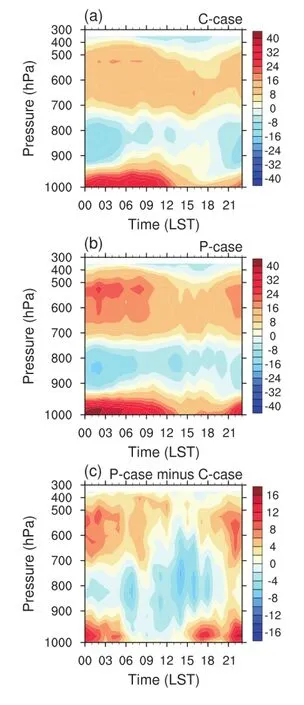
Fig.10.Temporal evolution of the microphysical latent heating profile for(a)C-case,(b)P-case,and(c)P-case minus C-case. Units are K s-1.
To further explore the physical processes governing aerosol-related precipitation change and redistribution over theBeijing–Tianjin–Hebeiurbanagglomeration,weexplored atmospheric variables related to convection and cloud microphysical properties.It was found that aerosol effects strongly enhanced CAPE in the areas of rainfall increase.CIN decreasedoverthese areas,with anorderof magnitudeless than CAPE.This suggests that the enhancementof convectiveprecipitation may make a greater contribution to the rainfall increase.Analysis of changes of the water vapor mixing ratio revealed that water vapor in the lower atmosphere increased over the areas of precipitation enhancement,which supported the development of convective activity.A change in mesoscale circulation in the mid-troposphere revealed strong cyclonic wind shear over the southern part of Beijing.This change was consistent with the analysis of modifications in atmospheric potential vorticity.Aerosols also enhanced ascending motion,triggering more cloud formation and convective systems.Anthropogenicaerosols modified the equivalent potential temperature,warming the lower atmosphere and cooling the upper atmosphere.Analysis of cloud microphysical properties showed that additional anthropogenic aerosols generated a larger number of smaller cloud droplets and narrower droplet spectrum width,thereby inhibiting rain formation processes.With stronger updraft strength in convection,more cloud droplets ascended above the freezing level and were transformed into ice hydrometeors.The extra latent heat released from phase transition further invigorated convection,leading to the rainfall increase over the urban areas.Under the polluted air conditions,microphysical latent heating increased,consistent with aerosols’invigoration effects.Therefore,we tentatively suggest that the aerosol indirect effect on cloud microphysical properties may well be the major driver of the simulated summer rainfall modification over the Beijing–Tianjin–Hebei region.
Wu et al.(2013)used WRF-Chem to examineaerosolimpacts on precipitation over China during the East Asian summer monsoon.Results showed that the aerosol microphysical effect induced ascent to the north(high aerosol areas) and descent to the south,leading to a precipitation shift from south to north.Their study also revealed that the aerosolinduced anomalies of precipitation were mainly contributed by the changes in vertical velocity associated with convection,while the horizontal advection of moisture played a significant role.In our study,numerical simulations also revealed aerosol-induced enhancements in vertical motion,local advection of water vapor,and convective energy,which are highly consistent with the results of Wu et al.(2013) in northern China.It should be noted that Wu et al.(2013) focused on the aerosol effects on summer monsoon precipitation produced by stratiform clouds and convective clouds on large scales.Our study examined the responses of summer precipitation to anthropogenic aerosols over a representative metropolis,which has important implications with respect to the verification of observational analysis on the relationship between aerosols and urban precipitation modification.Ntelekos et al.(2009)performed numerical experiments for three intense convective storm days and for two representative aerosol conditions.They found that increasing aerosol concentrations can lead to either enhancement or suppression of precipitation.Storms developing in areas of relatively high(low)concentrations of aerosols tended to enhance(suppress)the rainfall.Guo et al.(2014)conducted a case study of aerosol impacts on summer convective precipitation over northern China and found that the maximum rainfall rate above 30 mm h-1was enhanced,but that below 30 mm h-1was suppressed.Results from these case studies suggest that the impacts of aerosols on summer precipitation depend on the aerosol concentrations and atmospheric conditions.Our month-long simulation results with numerous rainfall events indicate the overall rainfall enhancement due to the impacts of anthropogenic aerosols.Future studies stillneed to employ more long-term and higher-resolution simulations to uncover the complex processes dominating the climatic impacts of anthropogenic aerosols on summer rainfall over urban areas.
Acknowledgements.This study was supported by the Strategic Priority Research Program—Climate Change:Carbon Budget and Relevant Issues,of the Chinese Academy of Sciences(Grant No.XDA05090207),the National Natural Science Foundation of China(Grant Nos.41275108 and 41105051).We appreciate the two anonymous reviewers’helpful comments during the evaluation of this paper,without which the quality of this study could not have been improved to its final level.
REFERENCES
Ackermann,I.J.,H.Hass,M.Memmesheimer,A.Ebel,F.S. Binkowski,and U.Shankar,1998:Modal aerosol dynamics model for Europe:Development and first applications.Atmos.Environ.,32,2981–2999,doi:10.1016/S1352-2310(98) 00006-5.
Andreae,M.O.,D.Rosenfeld,P.Artaxo,A.A.Costa,G.P. Frank,K.M.Longo,and M.A.F.Silva-Dias,2004:Smoking rain clouds over the Amazon.Science,303,1337–1342,doi: 10.1126/science.1092779.
Andreae,M.O.,C.D.Jones,and P.M.Cox,2005:Strong presentday aerosol cooling implies a hot future.Nature,435,1187–1190,doi:10.1038/nature03671.
Chan,C.K.,and X.H.Yao,2008:Air pollution in mega cities in China.Atmos.Environ.,42,1–42,doi:10.1016/j.atmosenv. 2007.09.003.
Chen,F.,and J.Dudhia,2001:Coupling an advanced land surfacehydrology model with the Penn State-NCAR MM5 modeling system.Part I:Model implementation and sensitivity.Mon. Wea.Rev.,129,569–585.
Chen,S.-H.,and W.-Y.Sun,2002:A one-dimensional time dependent cloud model.J.Meteor.Soc.Japan.,80,99–118.
Duan,F.K.,X.D.Liu,T.Yu,and H.Cachier,2004:Identification and estimate of biomass burning contribution to the urban aerosol organic carbon concentrations in Beijing.Atmos.Environ.,38,1275–1282,doi:10.1016/j.atmosenv.2003.11.037.
Fast,J.,and Coauthors,2009:Evaluating simulated primary anthropogenic and biomass burning organic aerosols during MILAGRO:Implications for assessing treatments of secondary organic aerosols.Atmos.Chem.Phys.,9,6191–6215.
Fast,J.D.,W.I.Gustafson Jr.,R.C.Easter,R.A.Zaveri,J.C. Barnard,E.G.Chapman,G.A.Grell,and S.E.Peckham, 2006:Evolution of ozone,particulates,and aerosol direct radiative forcing in the vicinity of Houston using a fully coupled meteorology-chemistry-aerosol model.J.Geophys.Res.,111, D21305,doi:10.1029/2005JD006721.
Fan,J.W.,L.Leung,Z.Q.Li,H.Morrison,H.B.Chen,Y.Q. Zhou,Y.Qian,and Y.Wang,2012:Aerosol impacts on clouds and precipitation in eastern China:Results from bin and bulk microphysics.J.Geophys.Res.,117,D00K36,doi:10.1029/ 2011JD016537.
Grell,G.A.,and D.D´ev´enyi,2002:A generalized approach to parameterizing convection combining ensemble and data assimilation techniques.Geophys.Res.Lett.,29(14),38-1–38-4,doi:10.1029/2002GL015311.
Grell,G.A.,S.E.Peckham,R.Schmitz,S.A.McKeen,G.Frost, W.C.Skamarock,and B.Eder,2005:Fully coupled“online”chemistry within the WRF model.Atmos.Environ.,39,6957–6975,doi:10.1016/j.atmosenv.2005.04.027.
Guo,X.L.,D.H.Fu,X.Guo,and C.M.Zhang,2014:Acase study of aerosol impacts on summer convective clouds and precipitation over northern China.Atmos.Res.,142,142–157,doi: 10.1016/j.atmosres.2013.10.006.
Iacono,M.J.,J.S.Delamere,E.J.Mlawer,M.W.Shephard,S. A.Clough,and W.D.Collins,2008:Radiative forcing by long-lived greenhouse gases:Calculations with the AER radiative transfer models.J.Geophys.Res.,113,D13103,doi: 10.1029/2008JD009944.
Janji´c,Z.I.,1994:The step-mountain eta coordinate model:Further developments of the convection,viscous sublayer,and turbulence closure schemes.Mon.Wea.Rev.,122,927–945.
Kaufman,Y.J.,D.Tanr´e,and O.Boucher,2002:A satellite view of aerosols in the climate system.Nature,419,215–223,doi: 10.1038/nature01091.
Khain,A.,D.Rosenfeld,and A.Pokrovsky,2005:Aerosol impact on the dynamics and microphysics of deep convective clouds.Quart.J.Roy.Meteorol.Soc.,131,2639–2663,doi: 10.1256/qj.04.62.
Khain,A.P.,2009:Notes on state-of-the-art investigations of aerosol effects on precipitation:A critical review.Environ. Res.Lett.,4,015004,doi:10.1088/1748-9326/4/1/015004.
Kusaka,H.,H.Kondo,Y.Kikegawa,and F.Kimura,2001:A simple single-layer urban canopy model for atmospheric models: Comparison with multi-layer and slab models.Bound.-Layer Meteor.,101,329–358.
Lacke,M.C.,T.L.Mote,and J.M.Shepherd,2009:Aerosols and associated precipitation patterns in Atlanta.Atmos.Environ., 43,4359–4373,doi:10.1016/j.atmosenv.2009.04.022.
Li,Z.Q.,F.Niu,J.W.Fan,Y.G.Liu,D.Rosenfeld,and Y.N. Ding,2011:Long-term impacts of aerosols on the vertical development of clouds and precipitation.Nature Geosci.,4, 888–894,doi:10.1038/ngeo1313.
Lin,Y.-L.,R.D.Farley,and H.D.Orville,1983:Bulk parameterization of the snow field in a cloud model.J.Climate Appl. Meteor.,22,1065–1092.
Liu,Y.G.,P.H.Daum,and R.L.McGraw,2005:Size truncation effect,threshold behavior,and a new type of autoconversion parameterization.Geophys.Res.Lett.,32,L11811,doi: 10.1029/2005GL022636.
McKeen,S.,and Coauthors,2007:Evaluation of several PM2.5forecast models using data collected during the ICARTT/ NEAQS2004 field study.J.Geophys.Res.,112,D10S20,doi: 10.1029/2006JD007608.
Mellor,G.L.,and T.Yamada,1982:Development of a turbulence closure model for geophysical fluid problems.Rev.Geophys., 20,851–875.
Miao,S.G.,F.Chen,Q.C.Li,and S.Y.Fan,2011:Impacts of urban processes and urbanization on summer precipitation:a case study of heavy rainfall in Beijing on 1 August 2006.J. Appl.Meteor.Climatol.,50,806–825.
Niyogi,D.,P.Pyle,M.Lei,S.P.Arya,C.M.Kishtawal,M. Shepherd,F.Chen,and B.Wolfe,2011:Urban modification of thunderstorms:An observational storm climatology and model case study for the Indianapolis urban region.J.Appl. Meteor.Climatol.,50,1129–1144.
Ntelekos,A.A.,J.A.Smith,L.Donner,J.D.Fast,W.I.Gustafson Jr.,E.G.Chapman,and W.F.Krajewski,2009:The effects ofaerosols on intense convective precipitation in the northeastern United States.Quart.J.Roy.Meteorol.Soc.,135,1367–1391.
Orville,H.D.,P.A.Eckhoff,J.E.Peak,J.H.Hirsch,and F.J. Kopp,1981:Numerical simulation of the effects of cooling tower complexes on clouds and severe storms.Atmos.Environ.,15,823–836.
Qian,W.H.,J.L.Fu,and Z.W.Yan,2007:Decrease of light rain events in summer associated with a warming environment in China during 1961–2005.Geophys.Res.Lett.,34,L11705, doi:10.1029/2007GL029631.
Qian,Y.,W.I.Gustafson Jr.,L.R.Leung,and S.J.Ghan,2009a: Effects of soot-induced snow albedo change on snowpack and hydrological cycle in western United States based on Weather Research and Forecasting chemistry and regional climate simulations.J.Geophys.Res.,114,D03108,doi: 10.1029/2008JD011039.
Qian,Y.,D.Y.Gong,J.W.Fan,L.R.Leung,R.Bennartz,D.L. Chen,and W.G.Wang,2009b:Heavy pollution suppresses light rain in China:Observations and modeling.J.Geophys. Res.,114,D00K02,doi:10.1029/2008JD011575.
Qian,Y.,H.L.Wang,R.D.Zhang,M.G.Flanner,and P.J. Rasch,2014:A sensitivity study on modeling black carbon in snow and its radiative forcing over the Arctic and Northern China.Environ.Res.Lett.,9,064001,doi:10.1088/1748-9326/9/6/064001.
Ramanathan,V.,P.J.Crutzen,J.T.Kiehl,and D.Rosenfeld,2001: Aerosols,climate,and the hydrological cycle.Science,294, 2119–2124,doi:10.1126/science.1064034.
Rosenfeld,D.,1999:TRMM observed first direct evidence of smoke from forest fires inhibiting rainfall.Geophys.Res. Lett.,26,3105–3108,doi:10.1029/1999GL006066.
Rosenfeld,D.,2000:Suppression of rain and snow by urban and industrial air pollution.Science,287,1793–1796,doi: 10.1126/science.287.5459.1793.
Rosenfeld,D.,and W.L.Woodley,2003:Spaceborne inferences of cloud microstructure and precipitation processes:Synthesis,insights,and implications.Meteor.Monogr.,Vol.29,59 pp.
Rosenfeld,D.,J.Dai,X.Yu,Z.Y.Yao,X.H.Xu,X.Yang,and C. L.Du,2007:Inverse relations between amounts of air pollution and orographic precipitation.Science,315,1396–1398, doi:10.1126/science.1137949.
Rosenfeld,D.,U.Lohmann,G.B.Raga,C.D.O’Dowd,M.Kulmala,S.Fuzzi,A.Reissell,and M.O.Andreae,2008:Flood or drought:how do aerosols affect precipitation?Science, 321,1309–1313,doi:10.1126/science.1160606.
Schell,B.,I.J.Ackermann,H.Hass,F.S.Binkowski,and A.Ebel, 2001:Modeling the formation of secondary organic aerosol within a comprehensive air quality model system.J.Geophys. Res.,106,28 275–28 293.
Shem,W.,and M.Shepherd,2009:On the impact of urbanization on summertime thunderstorms in Atlanta:Two numerical model case studies.Atmos.Res.,92,172–189,doi:10.1016/ j.atmosres.2008.09.013.
Shepherd,J.M.,2005:A review of current investigations of urbaninduced rainfall and recommendations for the future.Earth Interactions,9,1–27.
Shepherd,J.M.,and S.J.Burian,2003:Detection of urbaninduced rainfall anomalies in a major coastal city.Earth Interactions,7,1–17.
Stockwell,W.R.,P.Middleton,J.S.Chang,and X.Y.Tang,1990: The second generation regional acid deposition model chemical mechanism for regional air quality modeling.J.Geophys. Res.,95,16 343–16 367.
Streets,D.G.,and Coauthors,2003:An inventory of gaseous and primary aerosol emissions in Asia in the year 2000.J.Geophys.Res.,108(D21),8809,doi:10.1029/2002JD003093.
Tuccella,P.,G.Curci,G.Visconti,B.Bessagnet,L.Menut,and R. J.Park,2012:Modeling of gas and aerosol with WRF/Chem over Europe:Evaluation and sensitivity study.J.Geophys. Res.,117,D03303,doi:10.1029/2011JD016302.
van den Heever,S.C.,and W.R.Cotton,2007:Urban aerosol impacts on downwind convective storms.J.Appl.Meteor.Climatol.,46,828–850,doi:10.1175/JAM2492.1.
Wang,X.Y.,and Coauthors,2010:WRF-Chem simulation of East Asian air quality:Sensitivity to temporal and vertical emissions distributions.Atmos.Environ.,44,660–669,doi: 10.1016/j.atmosenv.2009.11.011.
Wang,Y.,Q.Wan,W.Meng,F.Liao,H.Tan,and R.Zhang,2011: Long-term impacts of aerosols on precipitation and lightning over the Pearl River Delta megacity area in China.Atmos. Chem.Phys.,11,12 421–12 436,doi:10.5194/acp-11-12421-2011.
Wu,L.T.,H.Su,and J.H.Jiang,2013:Regional simulation of aerosol impacts on precipitation during the East Asian summer monsoon.J.Geophys.Res.,118,6454–6467,doi: 10.1002/jgrd.50527.
Wu,Q.Z.,Z.F.Wang,A.Gbaguidi,C.Gao,L.N.Li,and W. Wang,2011:A numerical study of contributions to air pollution in Beijing during CAREBeijing-2006.Atmos.Chem. Phys.,11,5997–6011,doi:10.5194/acp-11-5997-2011.
Wu,Q.Z.,W.S.Xu,X.J.Zhao,and Y.J.He,2012:The spatial optimization of the PM10emission in Beijing and its verification by the numerical model.Acta Scientiae Circumstantiae, 32,2548–2558.(in Chinese)
Wu,Q.Z.,W.S.Xu,A.J.Shi,Y.T.Li,X.J.Zhao,Z.F.Wang,J. X.Li,and L.N.Wang,2014:Air quality forecast of PM10 in Beijing with Community Multi-scale Air Quality modeling (CMAQ)system:Emission and improvement.Geoscientific Model Development,7,2243–2259.
Zhang,Q.,and Coauthors,2009a:Asian emissions in 2006 for the NASA INTEX-B mission.Atmos.Chem.Phys.,9,5131–5153,doi:10.5194/acp-9-5131-2009.
Zhang,Y.,M.K.Dubey,S.C.Olsen,J.Zheng,and R.Zhang, 2009b:Comparisons of WRF/Chem simulations in Mexico city with ground-based RAMA measurements during the 2006-MILAGRO.Atmos.Chem.Phys.,9,3777–3798,doi: 10.5194/acp-9-3777-2009.
Zhang,Y.X.,and M.K.Dubey,2009:Comparisons of WRF/ Chem simulated O3concentrations in Mexico city with ground-based RAMA measurements during the MILAGRO period.Atmos.Environ.,43,4622–4631.
Zhao,C.,and Coauthors,2014:Simulating black carbon and dust and their radiative forcing in seasonal snow:A case study over North China with field campaign measurements.Atmos. Chem.Phys.,14,11 475–11 491,doi:10.5194/acp-14-11475-2014.
Wang,J.,J.M.Feng,Q.Z.Wu,and Z.W.Yan,2016:Impact of anthropogenic aerosols on summer precipitation in the Beijing–Tianjin–Hebei urban agglomeration in China:Regional climate modeling using WRF-Chem.Adv.Atmos.Sci.,
33(6),753–766,10.1007/s00376-015-5103-x.
27 May 2015;revised 12 November 2015;accepted 29 December 2015)
Jinming FENG
Email:fengjm@tea.ac.cn
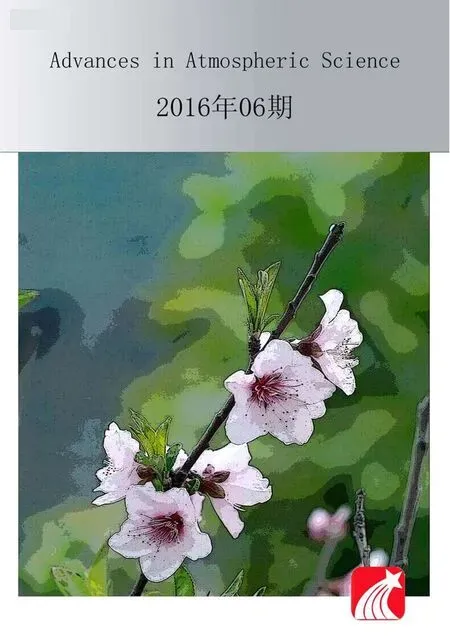 Advances in Atmospheric Sciences2016年6期
Advances in Atmospheric Sciences2016年6期
- Advances in Atmospheric Sciences的其它文章
- Estimation and Correction of Model Bias in the NASA/GMAO GEOS5 Data Assimilation System:Sequential Implementation
- Comparison of Constant and Time-variant Optimal Forcing Approaches in El Niño Simulations by Using the Zebiak–Cane Model
- Simple Metrics for Representing East Asian Winter Monsoon Variability: Urals Blocking and Western Pacific Teleconnection Patterns
- Influence of Internal Decadal Variability on the Summer Rainfall in Eastern China as Simulated by CCSM4
- A Double-Index Method to Classify Kuroshio Intrusion Paths in the Luzon Strait
- Impact of Spectral Nudging on the Downscaling of Tropical Cyclones in Regional Climate Simulations
